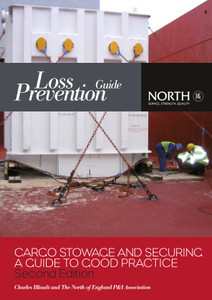
Due to the size and weight of pipes, they tend to be carried on the decks of cargo ships rather than in the holds. This exposes ship owners to considerably higher risk of damage and loss claims. This publication provides comprehensive guidance on the stowage of pipe cargoes, in line with applicable IMO regulations.
This guide helps to prevent inadequate or inappropriate pipe stowage and securing, stressing the importance of regularly tending to securing arrangements during a voyage. Worked examples show how all three securing methods can be properly verified using the advanced calculation method from the IMO Code of Safe Practice for Cargo Stowage and Securing.
There have been a number of losses or part losses over the last few years of blocks of pipes stowed on deck, principally on the hatch covers. Much consideration has been given to the reasons for those losses and ways by which such stowage may be adequately secured for the rigours of an ocean voyage.
The losses have resulted from one or a combination of the following:
- Inadequacy of securing arrangements
- inappropriate combination of securing systems
- severely adverse weather and sea conditions.
Before looking at the various technical aspects associated with securing a cargo of deck stowed pipes, the composition and vulnerabilities of the cargo should be studied. Large diameter pipes shipped by sea on deck are, in most cases, not simply pieces of break bulk but are highly sensitive and valuable items.
The pipes are often manufactured from special high alloy steel with great precision, are tested to withstand high pressures, have ends finished to comply with a specification (bevelled, threaded, etc) and are usually coated internally and externally with varnish, paint or cement.
Any damage to the ends or coating is likely to result in rejection of the pipe or high costs resulting from refurbishment. As such, large diameter pipes are best stowed under deck, and nothing in this book should be interpreted as encouraging a decision in favour of the shipment of pipes on deck.
Chapter 1 General Information
1.1 Introduction
1.2 Applicable regulations
Chapter 2 Guidelines on Stowage and Securing
2.1 Characteristics of pipes
2.2 Before loading begins
2.3 Stowage of pipes
2.4 Securing of pipes
2.5 Worked examples
2.6 Summary
Chapter 3 Other Considerations
3.1 Ensuring a compact block
3.2 Protection of pipes
3.3 Construction of stanchions
3.4 Care of the securing arrangements
Appendices Advanced calculation method
Verification of securing alternatives for deck stowed pipes – worked examples
NorthStandard is one of the leading providers of global marine insurance products and services across the maritime industries. Established through the merger of North P&I Club and the Standard Club in February 2023, NorthStandard brings together over 300 years of marine insurance heritage.
From headquarters in the UK and with offices throughout Europe, Asia and the Americas, NorthStandard offers a unique blend of worldwide presence and class-leading expertise across multiple specialist areas, including P&I, FD&D, War Risks, Strike & Delay, Hull and Machinery and ancillary insurance. Its Sunderland Marine and Coastal & Inland divisions also provide cover for owners’ fixed premium P&I, fishing vessels, inland waterway and coastal trading vessels and aquaculture. NorthStandard’s comprehensive local market and sector knowledge is underpinned by continuous investments in market-leading digital technologies.
NorthStandard is a leading member of the International Group of P&I Clubs (IG) and is fully committed to upholding the shared objectives of its 12 independent member clubs, which provide liability cover for approximately 90% of the world’s ocean-going tonnage.
- Number of Pages:
- 32
- ISBN:
- 9780955825705
- Binding Format:
- Paperback
- Book Height:
- 210 mm
- Book Width:
- 141 mm
- Weight:
- 0.2 kg
- Author:
Charles Bliault and Hermann Kaps
- Published Date:
- August 2019
- Preview:
- Yes
- Publication Date:
- August 2019






